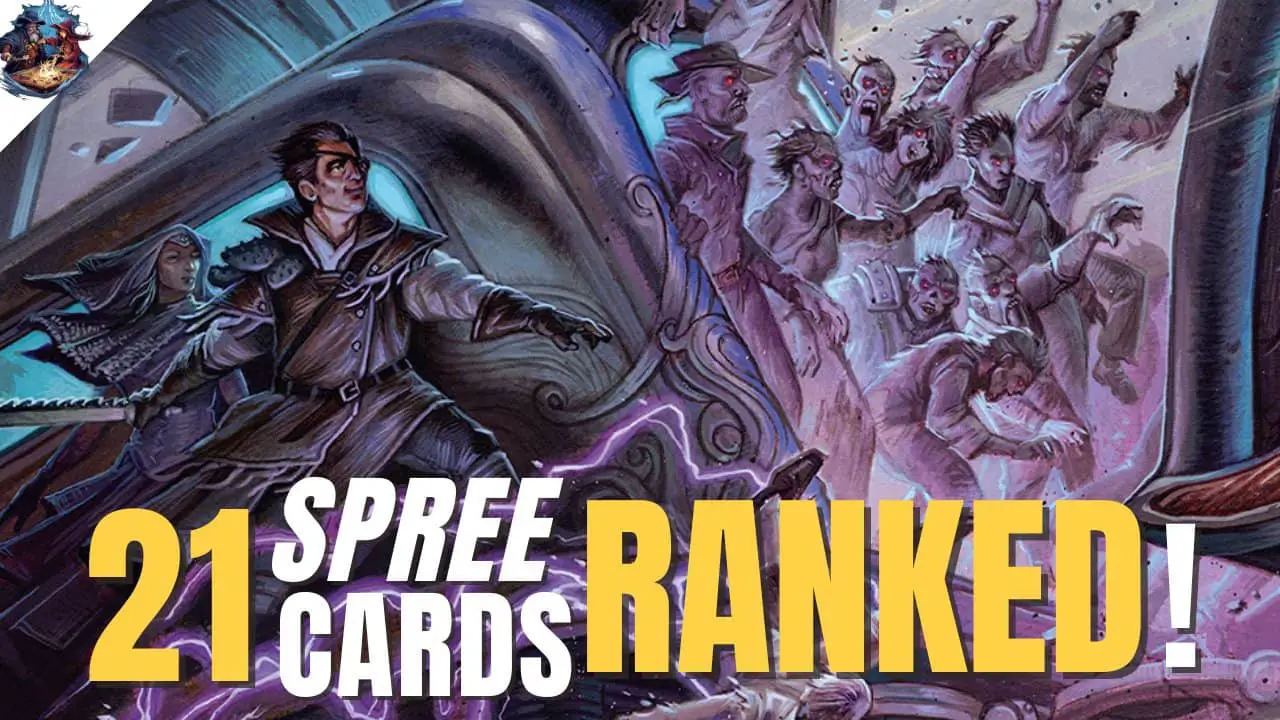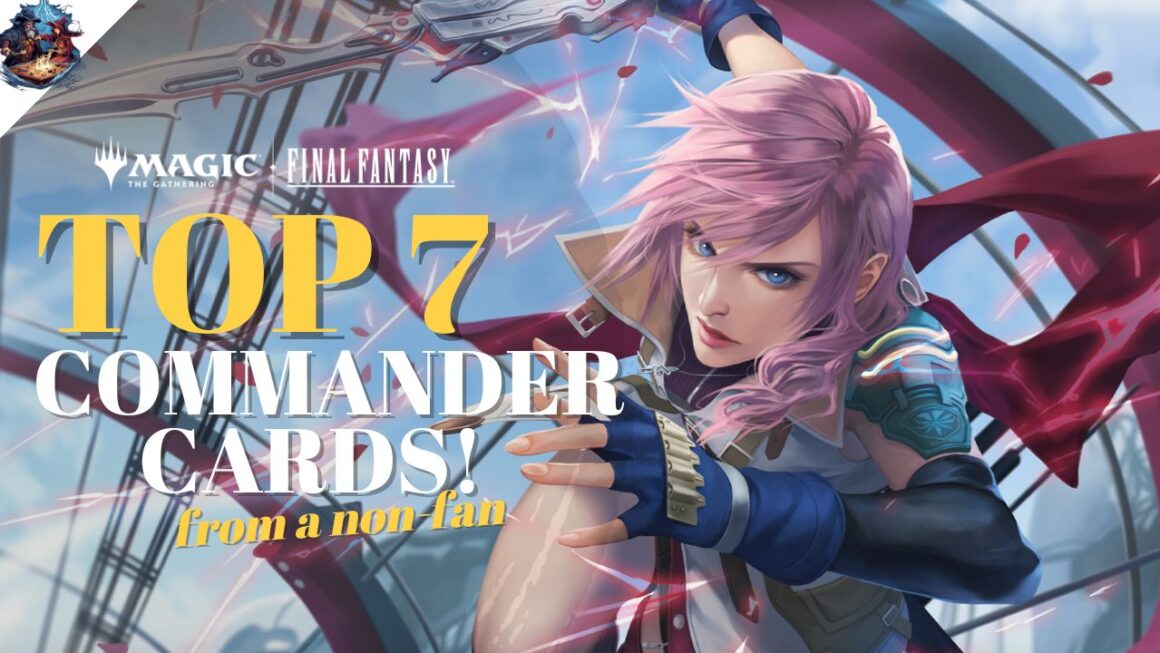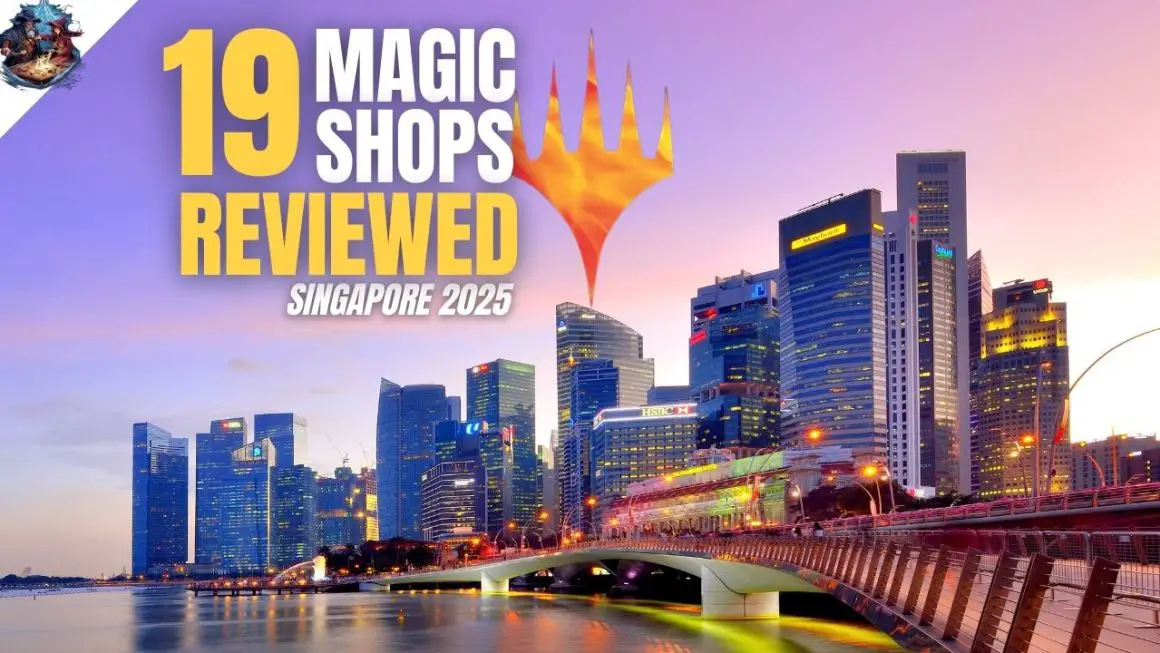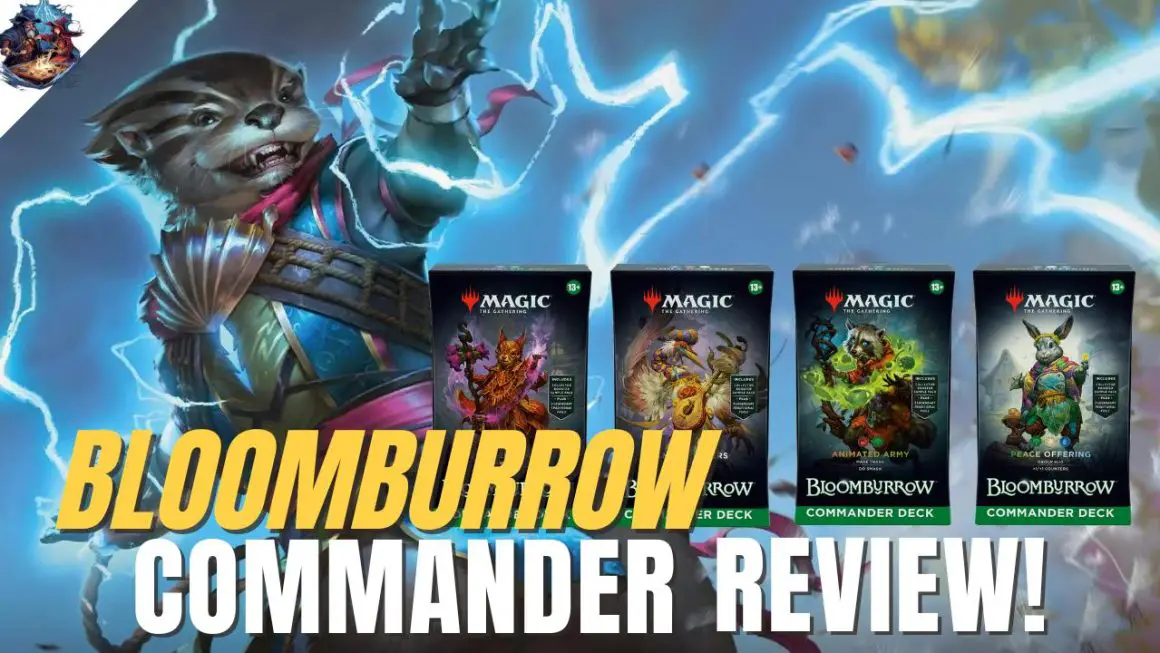With every new Magic: the Gathering set release, new mechanics are introduced to keep the game refreshing and open to experimentation. Outlaw of Thunder Junction’s new Spree mechanic puts an interesting spin on the ol’ Kicker mechanic, letting players pick and choose what they want to ‘kick’ a spell with. There are a healthy total of 21 new Spree cards in OTJ, and below you’ll find full rundown on each card’s abilities and power levels.
Spree cards generally will incur a higher cost if you’re choosing a single mode and comparing one-to-one with other cards of the same function. However, Spree becomes more effective the more modes you choose. That said, there are those that are just not worth your time or Mana. If you’re planning to attend Prerelease weekend or slot in some of these into existing Commander decks, then this guide is for you!
Spree Mechanics – Caught in the Crossfire
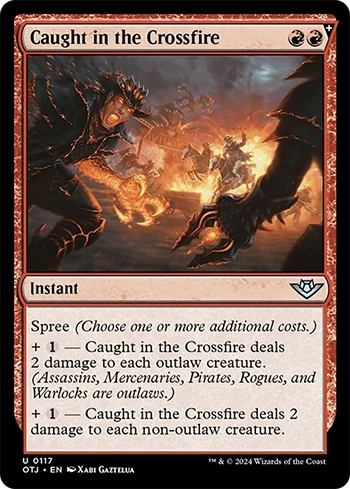
Caught in the Crossfire is the the new Spree variant of many mini red sweepers that have become. There was Fiery Cannonade that ignores Pirates, but now there is a somewhat better version in Caught in the Crossfire. You can build decks that not only revolve around Pirates, so how about a Pirates and Rogues deck? For 2 red and 1 colorless, you can spare your own Creatures but take out the enemy’s small critters.
What Spree lets you do is actually cast both modes (for 4 Mana) to deal 2 damage to each Creature. That’s a pretty bad deal as it lacks behind what other red sweepers can do. Burn Down the House and Hour of Devastation can deal 5 damage but it costs 5 Mana. Caught in the Crossfire will be most effective if you’re playing an outlaw-focused deck or Pirates/Rogue types, otherwise it’s best to exclude it.
Dance of the Tumbleweeds – Get a Land or Creature
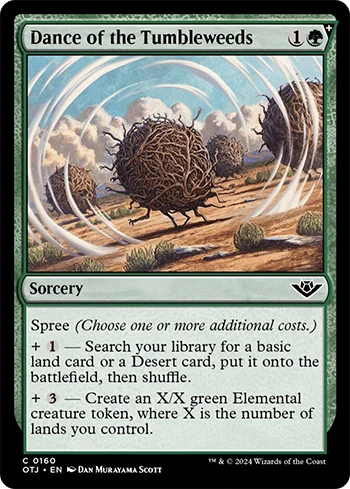
As a common Spree card, you don’t expect Dance of the Tumbleweeds to be amazing, but it does help you search for the Basic Land that you need, or create a nice big attacker/blocker in the late game. It is a Sorcery, so you won’t be springing any surprises on the opponent. To us it’ll be more effective to cast this in the mid to late game when you can spend 6 mana to not only grow your Land base, but also make that Elemental token bigger. Don’t forget, the Land that you searched from the first Spree mode will count towards the Power and Toughness of the Elemental.
Spending 6 Mana on your turn can be hefty, but you’ll have at least a 7/7 blocker to help you stay alive. Dance of the Tumbleweeds will shine more in Prerelease Sealed format, but not so in others. Casting it early is rather lackluster. Cultivate is a better choice for 3 Mana if you are in need of ramping or searching for a specific color.
Getaway Glamer – Balanced Offensive and Defensive Spree
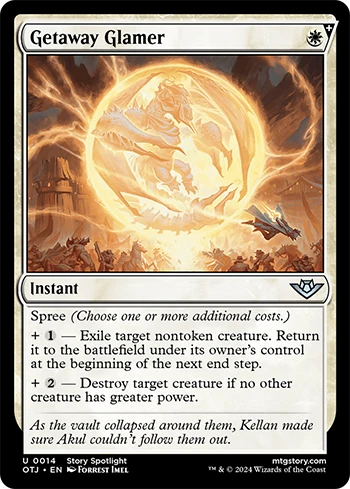
Getaway Glamer offers a defensive and offensive mode for a reasonable 2-4 Mana. The first mode is mostly used to save one of your Creatures when it’s being targeted. It’s too bad that this doesn’t work for Artifacts or Enchantments that your opponent wants to destroy, but for 2 Mana you can effectively save someone from dying, even from board wipes since it reenters the Battlefield only at the End Step.
The second mode is a little trickier. It effectively means you can target the strongest Creature out there. That’s usually good, but what if the main threat is actually a low-powered Creature that is somehow generating more value for the opponent? Cards like Drannith Magistrate and Thalia, Guardian of Thraben are just couple of Commander examples that will likely not be targetable by Getaway Glamer. This Spree card will also find it awkward to cast both modes at the same time since you’re either saving your Creature (which you have no control over when the opponent will target) or killing one of theirs. However, if you build your deck with plenty of Enter the Battlefield triggers, Getaway Glamer will become a lot easier to take advantage of.
Explosive Derailment – Abrade Upgraded?
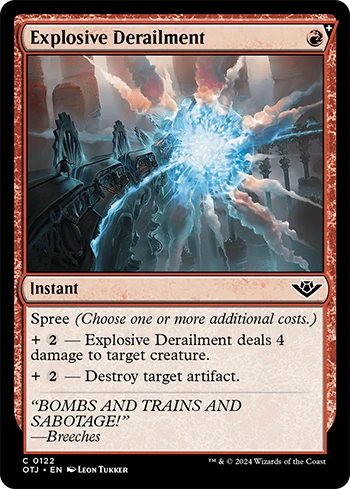
Let’s look at the classic Abrade, which deals 3 damage or destroys an Artifact for 2 Mana. Explosive Derailment shares both outcomes, offering another point of damage for 1 more Mana. Destroying an Artifact also requires a total of 3 Mana, more than Abrade. Taken individually, Explosive Derailment is still playable in Sealed but will likely fall behind Abrade in a Standard deck list.
Since Spree lets you cast both modes, is that a better deal then? For a total of 5 Mana, take out 2 threats on the opponent’s board, assuming one of them is an Artifact. It’s still fairly situational and for 5 Mana you could cast a spell that does more.
Great Train Heist – Glorious 3 Spree Modes to Choose From
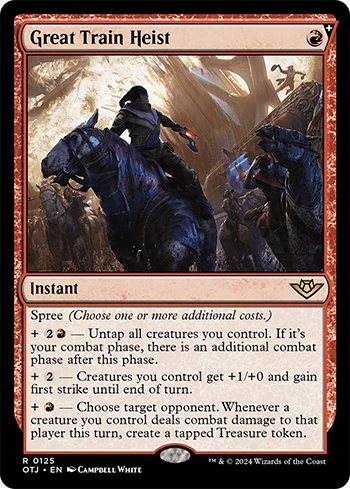
If there is a clear advantage of the Spree mechanic, it’s that more modes gives you more options to tackle different situations. Great Train Heist has 3 modes – the first gives you an additional combat step (3 Mana); the second gives a power and First Strike boost to your Creatures (2 Mana) and the last lets you create a Treasure token whenever any of your Creatures connect.
Extra combat steps are very characteristic of red, and casting it just for the first mode already makes Great Train Heist a worthwhile card to add into your deck. It costs the same as Seize the Day, but does more since it untaps all of your Creatures, rather than just 1. The second and third mode are less explosive, but casting the second Spree on its own could perhaps kill off enemy Creatures while keeping yours alive, since they gain First Strike. The third mode just sets you up for future big plays, and you’ll only use it if you have a sizeable force going at the opponent. Great Train Heist is a versatile card that can be used in combat-focused decks, but will be out of place in any other deck.
Insatiable Avarice – Tutoring on a Spree!
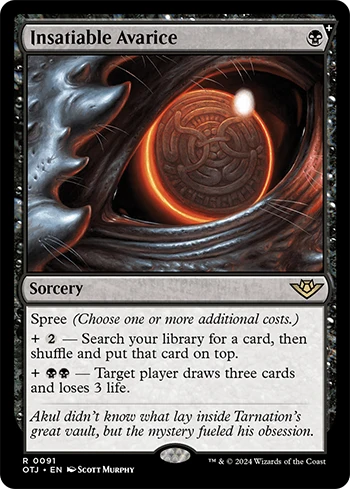
Possibly the best Spree card in the entire cycle, Insatiable Avarice was actually our spoiler card for Outlaws of Thunder Junction! We analysed closely what this card can and can’t do, and just to give you a hint: it’s pretty good.
Jailbreak Scheme – Expensive Blue Tricks
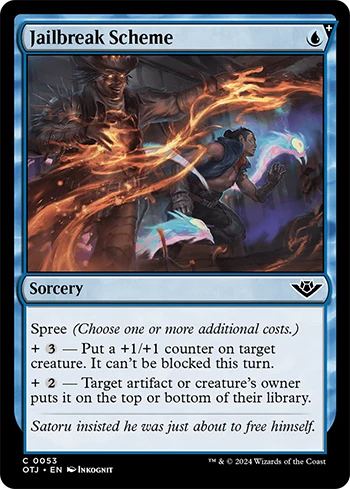
Jailbreak Scheme can either make one of your Creature guarantee a hit in combat, or temporarily remove a threat by putting a target Artifact or Creature back to the top of the Library. Neither one is that impressive when analyzed according to its cost.
The “unblockable” mode costs a total of 4 Mana – rather pricey when Rogue’s Passage does this for the same cost and can be activated each turn. The +1/+1 counter here is an attempt to make the deal sweeter but it’s not really helping. The second mode is an awkward form of temporary removal for an opponent’s threat. Since the owner can decide to put it on top or bottom of their Library, Jailbreak Scheme is merely a delaying tactic. Sometimes 1 or 2 turns is all you need, but other times it’s not. There are very few decks that will want to use this when there are better blue options out there.
Lively Dirge – The Budget Reanimator
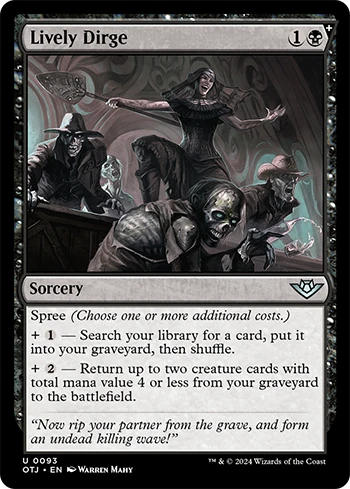
Lively Dirge is the Insatiable Avarice cousin but this time for Graveyards. It costs 3 Mana to put a single card into your Graveyard, which is neither bad nor great. It’s rather expensive for 3 Mana and not to get any immediate benefits (though you may have other cards in play that manipulate the Graveyard). The second Spree mode was meant to complement the first – an additional 2 Mana lets you bring back 2 Creatures from the Graveyard back to the Battlefield, albeit with a Mana Value restriction.
That restriction is what stops Lively Dirge from becoming meta. It likely best for Zombie-focused decks that are filled with low-costing Creatures. If you are casting just the second mode for 4 Mana, bringing back a Death Baron and a Championed of the Perished is not to be looked down on. But if you’re planning to reanimate something big and monstrous, which is often the case in black Commander decks, then Lively Dirge is just dead in the water.
Metamorphic Blas – Easy to Do Both Sprees
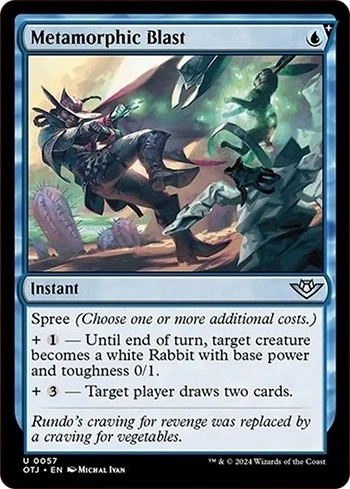
Metamorphic Blast does what blue likes to do: mutate Creatures and draw cards. The first mode can be sneaky and take out the biggest enemy Creature. Just bait it into blocking or attacking, turn it into a 0/1 and it will likely die in combat. For 2 Mana in the first Spree mode, it’s a fair deal.
The second mode is underwhelming on its own. 4 Mana to draw 2 cards makes it strictly worse than Quick Study or Chart a Course. Metamorphic Blast‘s saving grace is that as an Instant, you can save the second mode for the right moment. Casting both modes for 6 Mana is acceptable but far from groundbreaking. You’ll see more impact with the first mode, so not a bad include in your lower-powered Commander decks.
One Last Job – Doesn’t Go as Well as Planned
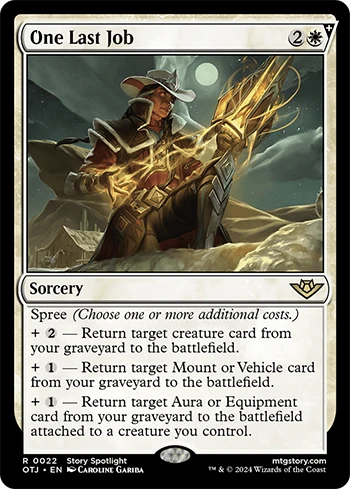
Rare Spree cards get the luxury of 3 modes to choose from, but with One Last Job, you’ll likely be casting all 3 in a very specific deck. It can return a Creature, Mount, Vehicle, Aura or Equipment back to the Battlefield for various costs. Mounts are a new card type, and Vehicles are truly niche. Perhaps the best combination of modes would be the first and third, bringing back a Creature and Aura/Equipment for 6 Mana. It’s a fair cost and at least the Aura/Equipment gets attached to any Creature you want.
At 7 Mana to cast all 3 modes, we just don’t see that happening very often, thus making this card less effective. It only requires 1 white Mana so One Last Job can easily be included in black-white Commander decks, for example. Use the other Spree card Lively Dirge to put a massive Creature into the Graveyard, then One Last Job to bring it back alive. This could be a dragon, demon or whatever you fancy.
Phantom Interference – Poor Choices
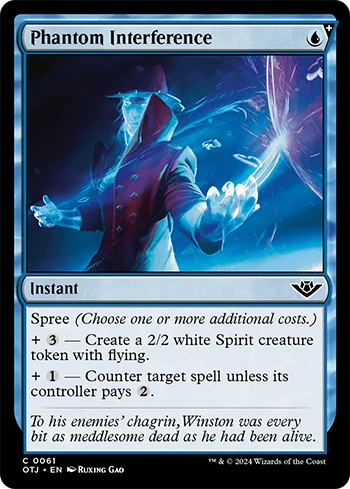
Phantom Interference is one of two Spree cards to provide a counter spell, and another mode to create a 2/2 Flying Spirit. Creating the spirit on its own is a rather poor deal, considering you pay 4 Mana. The best way to utilise the first mode is in conjunction with the second, which counters a spell unless its controller pays 2 (exactly the same as Quench. unfortunately, if you counter a spell in the early game (when the opponent is least likely to pay the 2 Mana), chances are you don’t 3 Mana to create the 2/2 Spirit. the counter spell mode becomes less effective in the late game, but that’s when you can spare the Mana for the first mode. You’re caught between 2 very unfavorable scenarios, and neither mode is great anyway. Use Phantom Interference as the new Quench in Standard, but don’t expect much more from it
Requisition Raid – Everything White Does
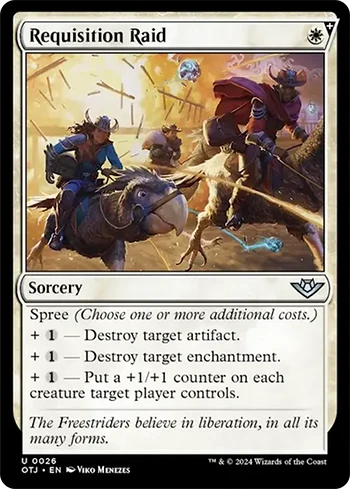
Starting with a base cost of a single white Mana, Requisition Raid is a very versatile Spree card that is only hampered by its Sorcery type. We can easily imagine players paying for the first 2 modes (total of 3 Mana) to destroy both an Artifact and Enchantment. That’s good value. The last mode is surprisingly cheap too, an additional generic Mana to put a +1/+1 counter on each Creature you control. White and green-white decks tend to go wide with many small attackers, so Requisition Raid‘s third option is going to see some use as well. Combine that third mode with either the first or second and either way you are getting amazing value with just 3 Mana.
Return the Favor – Two for the Price of One
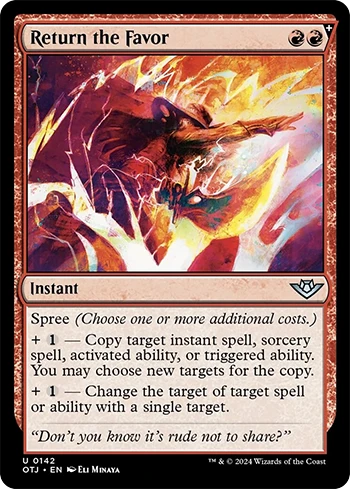
Return the Favor does so much of what red is known to do – copying certain things, and deflecting targets. The first mode is refreshing, since it allows your to copy even activated or triggered abilities, which other red cards like Reveberate and Fork can’t do. Have Terror of the Peaks (reprinted in Outlaws of Thunder Junction) out? You can use Return the Favor to copy its triggered ability and deal double damage. 3 Mana is a fair price to pay, however it’s still situational and not everything is ideal for copying. For example, you wouldn’t want to be copying opponents’ spells or abilities that benefit only them.
The second Spree mode is more serviceable and more likely to see play. It’s similar to Bolt Bend except that there is no chance of a cost reduction. Whenever your Creature is being targeted by a destroy or exile spell, Return the Favor turns the tables around, killing another Creature instead. Combine both modes and you can copy the opponent’s spell and choose new targets. You save your own, and affect 2 other targets for a mere 4 Mana. Very high value and can be used in more than a few budget Commander decks. As an uncommon, these won’t be hard to find either.
Rush of Dread – You’ll Dread Playing This
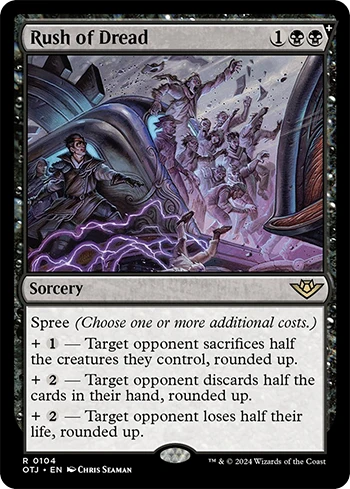
As much as we want to like this card, it feels like it only goes “halfway” or what any player would like to achieve. The 3 modes can take care of half the number of Creatures, cards in hand, or player life. The main issue here is that it doesn’t solve any problem. Killing half their Creatures isn’t going to stop the rest from killing you. Discarding 1 or 2 cards in the mid game is average for 5 Mana. Likewise the last mode is only great when the opponent is at a high life, and it’s not going to save you if they have a stronger presence on the Battlefield. Rush of Dread is a fun card but don’t expect it to see much play.
Rustler Rampage – Cheap Combat Trick
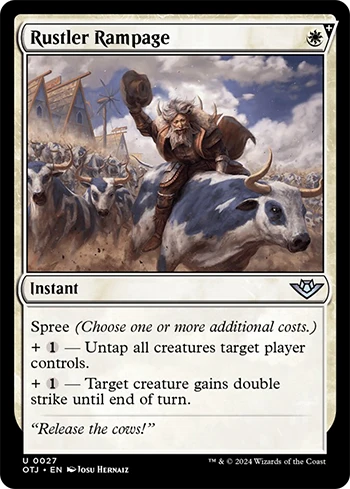
White has been getting the best Spree cards, and Rustler Ramage adds to the list of flexible Instants that any deck with white can utilize. The highest cost with Rustler Rampage is 3 Mana and you get 2 very usable effects. The first untaps all of your Creatures (usually you’ll want to target yourself), while the second gives a Creature Double Strike. Double Strike is so good at dealing a ton of damage so cast it just before your attackers deal combat damage. Because you are untapping your Creatures after they’ve been declared as attackers, they’ve gained pseudo Vigilance and can block during the opponent’s next turn.
You can also use the first mode as a surprise blocking tactic. When your Creatures are tapped and the opponent thinks they can get a few free points of damage, cast Rustler Rampage and allocate some profitable blocks to turn the tide. It may be a cheap Instant and only an uncommon, but the applications are wide.
Shifting Grift – Conditional Mind Control
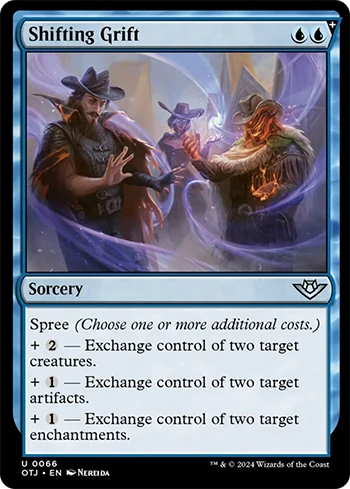
On the other end of the spectrum, blue appears to have the worst Spree cards from Outlaws in Thunder Junction. This uncommon offers 3 modes, and lets you exchange control of a Creature, Artifact or Enchantment (or all 3 if you like). The problem here is that even giving them a 1/1 body is a negative in our book. There are some alternatives such as Control Magic or Invoke the Winds that doesn’t require exchanges, though with some other drawback. To get maximum value from Shifting Grift, you’ll need 6 Mana, plus expendable Creature, Artifact and Enchantment to give away, and that’s assuming they have something you want.
The upside here is that Spree lets you choose the modes, so even if there aren’t any viable Artifacts or Enchantments to steal, you can just focus on the Creature mode. When you’re lagging behind on power level of cards in play, Shifting Grift could help turn things around. It still doesn’t feel good giving an opponent one of your own, so make sure your deck is well equipped to create ineffective tokens or vanilla Creatures. Shifting Grift will likely see the most play in Commander, when there are more targets to steal, and the double blue Mana isn’t restrictive for multi-color decks.
Smuggler’s Surprise – Green’s Best Friend
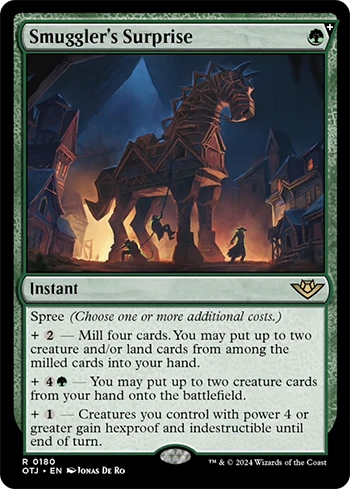
This card does so much that green wants to do, and to top it up does it extremely well. It’s let down only by its first mode, which is usable mostly for Landfall-style decks. It’s Smuggler’s Surprise‘s second and third modes that put it above the rest of the Spree cards in this set. Casting the second mode requires 6 Mana, but lets you put 2 Creatures directly onto the Battlefield from your hand. How about a Ghalta, Primal Hunger and a Ghalta and Mavren – a total of 24/24 Power and Toughness?
It’s alright if you’re not on the offensive. Defensively, Smuggler’s Surprise can cheat out surprise blockers, or when the dreaded board wipe comes, the third mode protects all your big Creatures. It’s a less inclusive Heroic Intervention, but having this option on a Spree card is enormous, to say the least. We’ll want to stock on a few copies of these to use in any future Commander decks with a green color identity.
Three Steps Ahead – Some Versatility, Little Efficiency
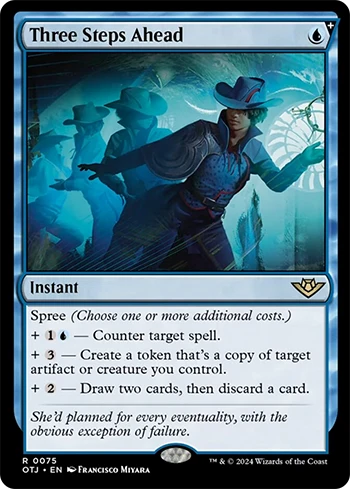
This rare, blue Spree card also offers 3 modes to choose from, each sufficiently relevant so that you’ll want to try to cast as many as possible. The first mode is the typical 3-Mana counter spell that has been ubiquitous in Standard. If there’s nothing to counter, you can always pick the second mode for a total of 4 Mana and make a copy of any of your Creatures and Artifacts. Not bad.
The third mode is one good way to sift through the top of your deck when you’re in need of a specific solution. The 3-Mana cost is, again, not the most efficient on its own. Three Steps Ahead can have a big impact when you pick all modes, though at a combined total of 8 Mana to cast, it feels a little underwhelming. Our advice is to play this for just 2 modes, or 1 if necessary. It’s the versatility of Three Steps Ahead that makes it a viable inclusion, but don’t hesitate to use it in the early game.
Thrash the Town – Built for Combat
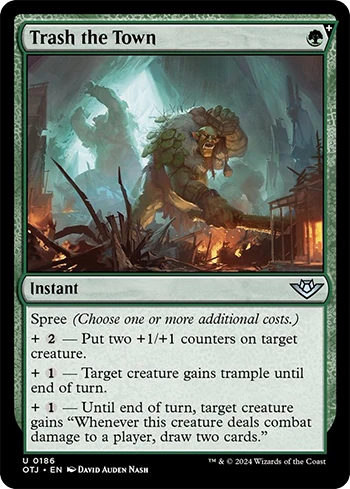
Thrash the Town is green’s entry for a combat-related Spree card, and it offers a couple of neat options. Pay 3 Mana and you get to put 2 +1/+1 counters on your Creature. It’s a neat combat trick that can usually save your own while killing the opponent’s combatant. The second mode that gives Trample is lacking on its own, but worth adding on if you are already picking the first mode and in an attacking scenario.
The third mode is our favorite, since you can cast it on its own for 2 Mana, and when timed right, essentially gives you 2 draws. Our recommended strategy is to always use mode one, and when possible, slap on mode three’s draw card effect. That way you ensure that your Creature is permanently buffed and you get more cards to push further in the game.
Unfortunate Accident – Vanilla Removal
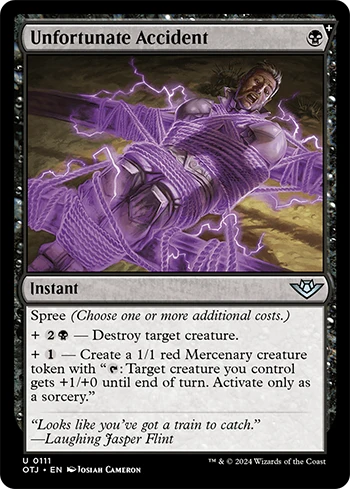
Unfortunate Accident is serviceable, just barely, unfortunately. The first mode destroys target Creature for 4 Mana – nothing special to look at here. There have been plenty of strong, black removal cards such as Infernal Grasp and Go for the Throat.
The second mode is baffling, since paying 2 Mana on its own to create a 1/1 token is unexciting. The token is a Mercenary and thus counts as an Outlaw, but outside of an Outlaw-themed build, there’s really no reason to cast the second mode other than to have a rather expensive blocker to deflect any big attack. Unfortunate Accident will still warrant a slot in Prerelease Sealed events, because removal spells are precious, but don’t expect to use this anywhere else.
Final Showdown – Mythic-Level Effects
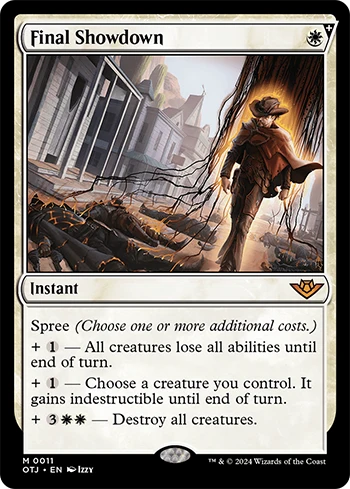
The only Mythic rare Spree card in Outlaws of Thunder Junction, Final Showdown lives up to its reputation. The first mode is a simplified Dress Down that can turn off triggers and abilities for any Creature that is already on the Battlefield. Although casting this in response to an “Enter the Battlefield” trigger will not stop it, the first mode can still be useful, if rather situational.
The second mode gives a Creature you control Indestructible for 2 Mana, while the last mode destroys all for 5 Mana. Taken individually, they aren’t outright strong effects. Final Showdown‘s big moment is when you cast modes 2 and 3 together. Keep your big boy alive, while destroying every other Creature. A one-sided board wipe, cast as an Instant for 6 Mana, can be a game changer. Think of it as white’s version of Cyclonic Rift, even though Final Showdown only protects a single Creature. It is a great card to include in a Voltron-styled deck.
End Step
For a first appearance, Spree cards are getting good representation in Outlaws of Thunder Junction. All 21 cards have their uses, but some a lot more applicable than others. Final Showdown and Smuggler’s Surprise stand out the most and will likely see more play. Some might see Spree as another variant of the modal system (the Charm cycle) or the Kicker mechanic. However the choice to add on additional benefits by paying more Mana is welcomed, and hopefully we’ll get to see more Spree cards in the future.

